|
Olympus Tough TG-810
14 megapixel stills/720p video camera that is shockproof, freezeproof, and waterproof to 33 feet
(by Conrad H. Blickenstorfer)
Olympus has been in the news as of late for all the wrong reasons, the corporate management kind that can affect a company's standing and progress. That's not what Olympus needs right now. I've always felt that Olympus cameras were underappreciated and a bit in the shadow of the likes of Canon and Nikon when, in fact, Olympus has many strengths of its own, and often innovation that puts them ahead of the game.
Case in point are compact cameras that you can take underwater without a housing. Olympus pretty much invented that genre and we've been big fans of the company's waterproof compacts ever since the Stylus 770 SW let divers go down to 33 feet with a little compact back in 2007. Initially, Olympus was alone with waterproof cameras, but then the competition realized that this was a pretty interesting niche market, one where compacts would not become bargain-priced commodity items anytime soon. So now pretty much every camera company has a waterproof model or two, and some are quite good. No one, however, has advanced the state of the art in underwater cameras like Olympus.
Below is what the camera looks like. And yes, the picture of the 25-foot whale shark was taken with it.
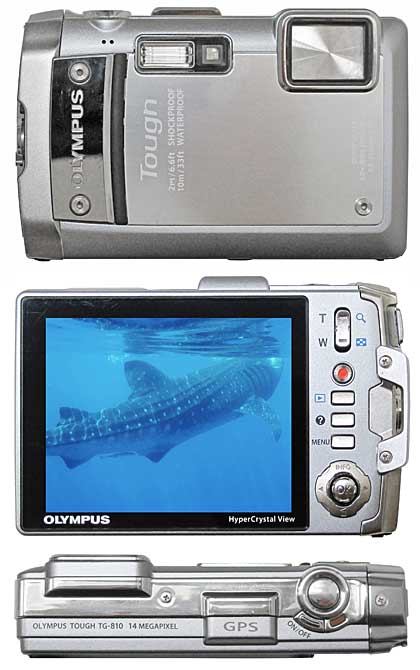
So prolific is Olympus that the Tough TG-810 camera I am writing about here, introduced in March of 2011, has already been succeeded by not only the TG-820 (announced February 2012), but also a new top-of-the-line model: The Tough TG-1 that can go even deeper, has a super-fast lens and numerous other improvements. The TG-810, however, remains relevant, and the concept remains the same. So in this article we're reporting on how the TG-810 made out through a full year of tough dive trips and very diverse diving.
What do you get with the Tough TG-810?
What you get is a camera that no outdoors person should be without. And it's also just perfect for divers. Its ability to be taken down to a depth of 33 feet sets it apart from lesser waterproof cameras with limits of five or 10 feet. They are all tough and you can take them all just about anywhere. But when it comes to actual diving, ten and 33 feet is the difference between snorkeling only and taking the camera along on dives. Sure, many dives go deeper, but there is a lot of great scenery in shallow waters and our experience has shown that the TG-810, like the 1030 SW and 770 SW before it, won't mind brief drops below that limit (we routinely used the old Stylus 770 SW down to 50 and 60 feet). The big thing here: not needing to take along a bulky underwater case is priceless.
But diving is not all the TG-810 can do. Thanks to a rugged metal body, extensive sealing and shock-absorbing construction, the camera can survive drops from two meters, or 6.6 feet. Icy cold temperatures do not affect this camera as it is freezeproof down to 14° Fahrenheit. So it's a perfect companion for sledding, skiing and snowboarding as well. Finally, the TG-810 is crushproof as well. Its tough case and reinforced LCD can withstand 220 pounds of pressure.
The tough Oly can do all this while still being a rather compact and quite elegant camera you can take anywhere. It has a footprint of 3.9 x 2.5 inches, is an inch thick, and weighs about 8 ounces. That actually makes the TG-810 a bit larger and heavier than its predecessors, but then again it has considerably more functionality as well. And as we found out when inspecting the insides of a 770 SW, this type of camera is jam-packed full of circuitry and tons of little parts. The longer 5X optical zoom is completely internal, which means there is no annoying lens barrel that motors in and out. And even though the TG-810 can stand up to deep water, dust, crushing, sand and freezing temperatures, it's also a rather powerful full-function digital camera with all the features you expect from a modern point & shoot compact, including HD video.
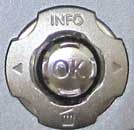 Despite its many features, the TG-810, like its predecessors, is fairly easy to use right out of the box. We do miss the mode dial of earlier models, but there are so many more functions now that replacing the hardware dial with menu selections was probably necessary. While all controls are redesigned, they remain quite small. There is now a red button for video, and below that three small buttons for playback, help and menu. The four-way navigation pad with an "OK" button in its center has been replaced with a small navigation knob. Despite its many features, the TG-810, like its predecessors, is fairly easy to use right out of the box. We do miss the mode dial of earlier models, but there are so many more functions now that replacing the hardware dial with menu selections was probably necessary. While all controls are redesigned, they remain quite small. There is now a red button for video, and below that three small buttons for playback, help and menu. The four-way navigation pad with an "OK" button in its center has been replaced with a small navigation knob.
The expanded internal zoom starts wide at 28mm and goes all the way up to 150mm (both in 35mm equivalent parlance). Starting wide is well suited for underwater photography where a wide lens always comes in handy. And on dry land, a longer zoom is always appreciated.
Below is a picture we took while snorkeling with whale sharks off Isla Mujeres in Mexico. Having the small and handy TG-810 made swimming to, and after, those gentle giants a whole lot easier than it would have been with a big, bulky camera in an underwater case!
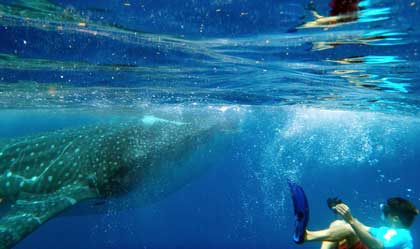
Features
It's probably fair to say that most Olympus Tough cameras are bought because of their impressive environmental ruggedness specifications. The camera market also has changed insofar as camera phones have pretty much taken over from inexpensive dedicated digital cameras on the low end while the more serious photographers now buy either mirrorless cameras with exchangeable lenses (like the Olympus PEN models) or digital SLRs. That doesn't mean, however, that the TG-810 is short on features or technology. So here are some of the features you get with this camera:
There are, of course, all the usual tricks and whistles and bells that have become mandatory even for basic digicams, such as increasingly powerful face detection modes that can find one or more faces in a setting and make sure they are in focus and properly exposed, even when people are moving. And, for whatever it's worth, there's even a pet mode now that will take a picture as soon as it detects your cat or dog.
Unlike older waterproof cameras from Olympus, the TG-810 has dual image stabilization that uses both higher sensitivity/higher shutter and mechanical sensor-shift technology to reduce or eliminate blurriness in pictures.
Cameras are about their electronic guts these days as much as they are about optics. Here, the TG-810 benefits from the Olympus TruePic III+ Image Processor that was originally developed for digital SLRs and now delivers more vibrant colors, smoother edges, less noise and higher overall speed.
Another fundamental shift is in video. QVGA (320 x 240) and VGA (640 x 480) is no longer enough for any serious camera. It's all high definition now, and so Olympus gave the TG-810 the ability to record in wide-screen 720p HD format with a one-touch red button. That's 1280 x 720 pixel and, while not full 1080p (1920 x 1080 pixels), it is good enough to look great on today's HDTVs. It is also a huge improvement over some of the earlier Oly underwater cameras (like the 1030) that limited you to 10 second clips.
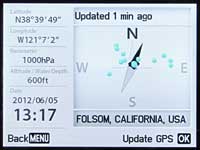 GPS is yet another technology that is increasingly finding its way into cameras, and the TG-810. With GPS on, the camera records location data for each image. You can then use it in a variety of ways, including maps that show where pictures were taken. And there's also a compass that puts those in most dive computers to shame. There is also a manometer that shows altitude on land and depth when underwater. GPS is yet another technology that is increasingly finding its way into cameras, and the TG-810. With GPS on, the camera records location data for each image. You can then use it in a variety of ways, including maps that show where pictures were taken. And there's also a compass that puts those in most dive computers to shame. There is also a manometer that shows altitude on land and depth when underwater.
Ever since the movie "Avatar," 3D is available in an increasing number of TVs, displays and cameras, and the TG-810 can shoot 3D pictures. It does that by taking a shot, then automatically taking another of the same scene or subject as you move to a slightly different position.
There is tap control where, if turned on, you can tap on the left, right and top of the camera to bring up menus and navigate through them.
As in some earlier ruggedized models, there is Shadow Adjustment Technology that analyzes shots of subjects in front of bright backgrounds and then exposes things properly. In essence, it compensates for extreme contrast where the shadow areas on the foreground subject are underexposed and lack visible detail.
The camera also has an LED Illuminator that works like a mini-flashlight on the front of the camera to enhance focus and exposure for macro shooting. It is also great for underwater close-ups where light is scarce.
There is a large 3.0-inch high resolution (960k pixel) LCD that does not only have a very wide viewing angle in all directions, but also uses the Olympus HyperCrystal III LCD technology to reproduces true colors with an optimized dynamic contrast ratio. The display also has anti-reflective and water-repellent coatings.
While the TG-810 does not have any manual modes, there are 26 scene modes in addition to auto: portrait, dynamic portrait, landscape, night scene, night + portrait, sport, indoor, candle, self portrait, sunset, firework, cuisine, document, beach and snow, underwater snapshot, underwater wide 1 and 2, underwater macro, and underwater movie, pet cat, pet dog, snow. There are eight "magic" modes (pop art, pin hole, fish eye, drawing, soft focus, punk, sparkle, watercolor). There is also a very nice panorama mode. In "P"rogram mode, you have control over most settings (albeit not aperture or shutter).
Like other Olympus cameras, the TG-810 has both a macro and a super-macro mode. The macro mode goes from eight inches to infinity whereas super-macro goes from a very close 1.2 inches to about two feet. This is great as Olympus underwater cameras excel at macro photography. In addition, there's a S-Macro LED mode where the illuminator light comes on for super macro shots between three and eight inches.
The camera uses standard SD cards (the costly and hard-to-find xD-Picture cards are finally gone). Internal storage remains a meager 15MB or so, enough for just two 14mp pictures. Why it's possible to get a 16GB MP3 player for almost nothing, but there's only so little backup memory in today's cameras is beyond me.
The camera uses a 925-mAH LI-50B battery that is good for about 250 pictures on a charge. The battery is charged in the camera via USB; there is no battery charger included.
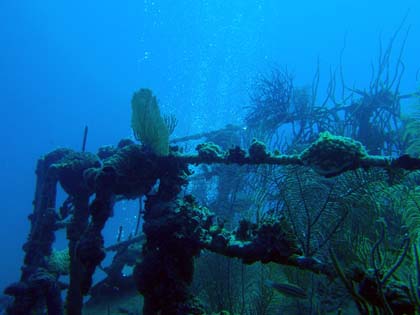
Diving impressions
We gave the Olympus Tough TG-810 a very good workout during the time it was with us. The camera accompanied us on dive product review trips to Socorro, Cancun/Isla Mujerez, Islas Coronados, and Roatan in Honduras. And became very familiar with both the camera's strengths and its limitations.
Socorro
The TG-810 first accompanied us on a 9-day liveaboard trip to the Islas Revillagigedos, also known as Socorro islands, a remote group of islands about 250 miles west of the Pacific coast of Mexico. The place is famous for its pelagics sightings, especially giant mantas. Unfortunately, it is also wild and deep, and all the diving is done from the boat. Here, the TG-810 came in handy to document our trip, but the actual dives were all too deep for it. So the only underwater pictures we got was from a bit of snorkeling. The picture below shows returning divers on their 15 foot safety stop.
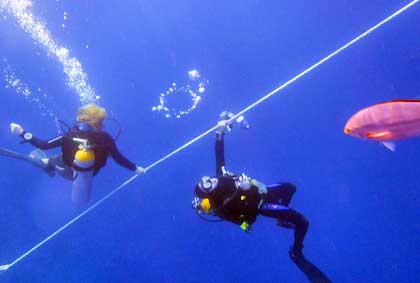
Cancun/Isla Mujeres
Cancun is located on the north-east of the Yucatan peninsula. We chose it because of its proximity to Isla Mujeres, one of the world's greatest places to see and snorkel with whale sharks. Diving off Cancun itself isn't as exciting as off nearby Cozumel, with few reefs and mostly shallow sand bottom. Most dives there were in the 20-50 feet range, and we had great fun with the TG-810. Once again it served as well as a general camera around the beach and pool, and we also took it on some of the shallower scuba dives. Though these waterproof cameras have now been around for a few years, people are always surprised that you can take a camera without housing underwater. Many are convinced that taking it under was by accident and that the camera would flood and be ruined. It's always a great conversation piece.
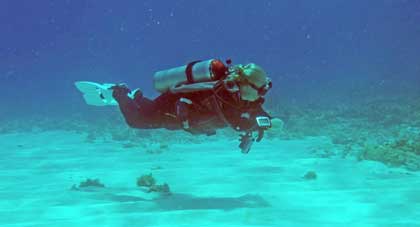
Where the TG-810 really came in handy was when we went on a two day trips off Isla Mujeres to swim with whale sharks. It's about an hour ride out into the ocean, and we hit the jackpot with the weather (bright and sunny), number of whale sharks (almost 100), and water conditions (flat, blue, clear). Whale sharks do not shy away from snorkelers nor do they seem to have an interest in them. They move slowly and snorkelers can keep up with them, at least for a while. The smaller and less bulky your camera, the better when trying to keep up with whale sharks. The TG-810 was perfect here!
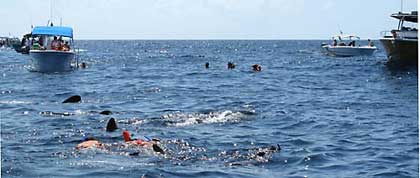
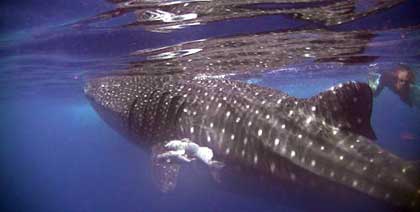
Coronados Islands
The Coronados are a small groups of islands south of San Diego in Mexican waters. We took the Olympus TG-810 on a dive in a shallow spot where we were surrounded by several dozen playing sea lion pups. Once again, having a small and handy camera without a big housing made all the difference.
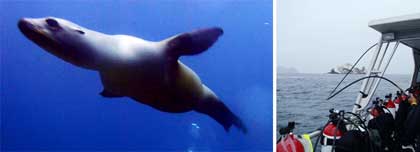
Roatan
The Honduran island of Roatan is one of our favorite dive destinations. The CoCo View Resort is a diver's paradise with shore as well as boat diving, and also the wreck of the "Prince Albert," a 140-foot tanker/freighter that sits in about 65 feet of water, with the upper part of the wreck at 30 to 45 feet. Taking the TG-810 along on dives here was wonderfully liberating as the camera is so small that it never was in the way. Roatan has gorgeous walls that start at 15 to 20 feet, and so we could take the Olympus along for some gorgeous dives. The picture below is from inside the wreck at about 35 feet.
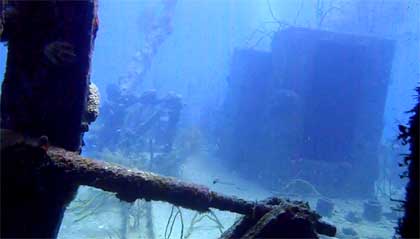
In Roatan we also used the TG-810 for experimenting with underwater nighttime fluorescent imaging. To see fluorescence during a night dive, you need a special type of light that excites/reveals the fluorescence and also special goggles and filters for the camera. We got the necessary gear from a company called NIGHTSEA and used the handy TG-810 as the camera of choice. To get pictures like the below, we turned the flash off, illuminated the subject with the special blue light, and recorded it in 720p movie mode. The results were stunning (also see our Night dives like you've never experienced before article).
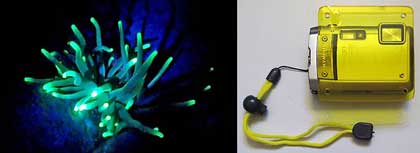
Observations
Having had ample experience with earlier Olympus waterproof cameras, we found a lot to like with the TG-810. Many of our earlier concerns had been addressed (locking battery compartment door, use of SD Cards, HD video, video clip length, LCD size and quality, etc.), but nothing is ever totally perfect.
In our dive notes we had frequent complaint entries about the tiny controls that are hard to see and operate underwater, and nearly impossibly so with gloves on. We didn't like the tiny control knob that replaced the standard 4-way diamond; it is very hard to reliably operate under water, and the tiny embossed markings are impossible to read. Likewise, the zoom rocker is simply too small. For divers, all controls should be larger and better marked.
Getting good color underwater is always an issue as colors disappear at depth. The TG-810 compensates with underwater white balance modes and other settings, but those are often too aggressive, resulting significant oversaturation. We also noticed red blotches in many pictures, which may be the result of the camera firing the flash when it's not supposed to (though they also often appeared with the flash off).
We didn't like that the camera doesn't come with a separate battery charger because it means you can't use the camera while the battery is charging, even if you have a backup battery.
We found that, more so than with earlier Olympus underwater cameras, increasing water pressure disabled some controls as we approached the depth limit. This can lead to missed shots or unwanted operations. The 33-foot depth limit still means that divers always have to make a conscious decision as to whether to take the camera on a dive or not. One solution is to get the PT-051 deepwater housing for the TG-810. At around US$250 it's a great buy and means you can always put the camera in the housing if you're unsure if the dive is deeper than what the bare 810 can handle.
Bottom line
Olympus practically wrote the book on tough, waterproof cameras, and their experience shows in the 14-megapixel TG-810. It is a very competent all-around camera that won't break, takes decent pictures, can take 720p HD video, has a nice high-res 3.0-inch LCD, and brims with features.
The 5X 28-140mm internal optical allows both wide angle photography and good magnification. The camera has several underwater modes as well as useful features like GPS, shadow adjustment, in-camera editing and more.
There are some things I'd change. First, the control buttons and especially the directional know are too small and almost impossible to use underwater where you're wearing a mask and lighting can be dim. With gloves on, they are impossible to use. Likewise, the tiny labels and writing etched next to controls becomes essentially unreadable. Second, the controls become unreliable as you approach the depth limit; they should at least work reliably down to the rated 33 feet. Third, in default mode, the camera oversaturates underwater. Finally, there are so many menu-controlled features that it's often difficult to use it underwater. Simpler would be better.
Overall, the good far outweighs the areas that need improvement in this camera. Being able to take it on, into and underwater without a bulky housing is wonderful, and image quality is quite good. For outdoors people, and divers, the Olympus Tough TG-810 should be a standard part of their gear.
We like:
- Attractive, mature sports and outdoor camera
- Real diving possible with 33 feet depth limit
- Inherent waterproofing provides peace of mind when handling in/around water
- Can survive 6.6-foot drops and 14 degree temperature!
- Very good wide viewing-angle, high-res 3.0-inch LCD
- Unlimited 720p HD video with one-button trigger
- Uses standard SD cards
- 5X 28-140mm optical zoom allows wide angle shooting
- Very good underwater macro modes
- LED illumination comes in handy
- Impressive GPS integration
- Lock for battery compartment
- Optional PT-051 deepwater housing
Not so much:
- Strictly point & shoot
- Tiny controls hard to use and read underwater
- Over-zealous underwater depth warnings
- Tiny gray on silver labels difficult to read
- Elegant metal body can get scratched
- Water pressure can disable controls at depth
- Standard settings tend to oversaturate colors underwater
|










